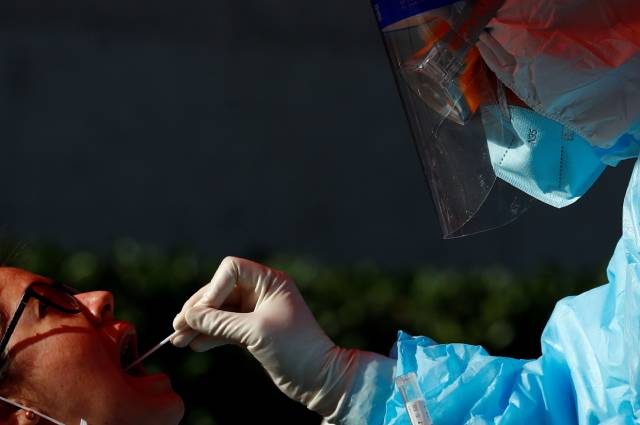
The target persons to be tested under the national government’s new expanded targeted testing program is similar to the ones the health department previously sought to prioritize under the formerly used term “mass testing.”
During the virtual press briefing on May 19, presidential spokesperson Harry Roque announced that the “expanded targeted testing” is the official term to be used to refer to the government-sanctioned protocol to detect cases of novel coronavirus in the country.
Roque also emphasized that the government does not have the capacity to perform “mass testing” as the scale of Wuhan, China, considered the epicenter of the new virus which causes COVID-19.
The government of Wuhan reportedly planned to test their 11 million residents.
This was a reiteration of his statement during the press briefing on May 18, wherein he admitted that the government “still” does not have plans to carry out the same testing approach in Wuhan.
In the same briefing on Tuesday, Roque also had a tense exchange with reporters after he accused a reporter from CNN Philippines of misquoting him, which he alleged caused the public’s confusion.
“Mali kasi iyong term na ginamit mo kaya tuloy nagkagulo sa twitter. Kaya nga po ang pakiusap ko sa ating mga kasama sa media, ingat lang po sa reporting,” Roque said.
When pressed anew to clarify his previous remark on why the government could not carry out testing to a larger group of Filipinos, Roque stressed that the government will not perform the same measure and sought to do a targeted system instead.
Defining mass testing and the expanded targeted version
Roque erroneously defined the mass testing initiative, which the public had been calling for since the start of the quarantine period last March, as requiring the entire population of the Philippines to undergo COVID-19 detection procedures.
“Hindi po mass testing ang ginagawa natin, it is expanded targeted testing at wala naman pong bansa sa mundo na lahat ng kanilang mamamayan ay tine-test,” Roque said.
Instead of testing all Filipinos, Roque said that the government’s program mandates only specific individuals to undergo testing procedures.
These are the following:
- All symptomatic cases
- All individuals who came from other countries prior to quarantine
- All individuals who came into contact with the previous two
- All individuals who tested positive with the rapid antibody test
- All overseas Filipino workers who needed PCR tests before returning home
The presidential spokesman also explained that the benchmark is to test between 1% or 2% of the entire population and higher than 10% in the epicenter, which is in Metro Manila.
“Ang susi sa testing ay work on benchmarks, ibig pong sabihin nito ay 1 to 2 percent of the population of the entire country or in the case of an epicenter, even higher than up to 10%. At iyan po ang ninanais natin sa Metro Manila,” he said.
State-run People’s Television even shared an infographic about it on Twitter to provide further clarification to Roque’s words.
Presidential Spox Harry Roque: Mali po ang ginagamit nating term na mass testing. Ang tawag po dapat ay expanded targeted testing. Walang bansa sa buong mundo na tine-test ang lahat ng kanilang mamamayan pic.twitter.com/y9IitOPNcj
— PTVph (@PTVph) May 19, 2020
The same approach, different term
Filipinos who had been calling for mass testing before criticized Roque for being the one who caused the confusion from the beginning.
They emphasized that the initiative used the word “mass” because this involves widespread testing of all suspected cases and aggressive contract tracing.
To make it easier, others likened mass testing to other social activities involving large group of Filipinos.
“Sa Pilipinas lang naguguluhan ang mga tao sa term na “mass testing”. Why? We can also reflect on the meaning of these terms: mass grave, mass wedding, mass gathering, mass shooting, mass promotion, etc,” the user said.
An alliance of Filipino scientists called Scientists Unite against COVID-19 shared the infographic about the same strategy they had been petitioning the government to do.
How many times do we have to spell out MASS TESTING for you, Harry Roque?#MassTestingNowPH pic.twitter.com/pg9FmWWRRz
— Scientists Unite Against COVID-19 (@TestCOVID19PH) May 19, 2020
Based on the infographic, the organization stated that these should be tested:
- All suspected cases
- All close contacts of confirmed or probable cases
- Regular testing of all frontline health care workers
- Surveillance for high-risk communities or vulnerable populations
A common term used by health organizations
Mass testing is also the term used by the World Health Organization and the Department of Health to refer to the need to detect COVID-19 patients as part of the process to “flatten the curve” or reduce the number of cases to a manageable level.
Moreover, Health Undersecretary Maria Rosario Vergeire previously announced that the DOH set April 14 as the date where they will start its ramped-up efforts to carry out these tests to “vulnerable members of the population.”
“The mass testing that we’re planning is targeted. We need to prioritize the vulnerable members of the population such as pregnant women, those who are immunocompromised, and our front-line health workers who have the highest exposure to the virus,” Vergeire said.
GMA reporter Atom Araullo, meanwhile, argued that regardless of the semantics, the public should be more vigilant if the government is actually performing the much-needed testing activities.
“Test at the right time, at the right frequency, using the right tests, targeting the right demographic. Let’s move beyond semantics,” he said on Twitter.
To reiterate, mass testing ≠ universal testing (not everyone of course). Mass testing ≠ indiscriminate testing (strategic and targeted for sure). Test at the right time, at the right frequency, using the right tests, targeting the right demographic. Let’s move beyond semantics.
— Atom Araullo (@atomaraullo) May 20, 2020









